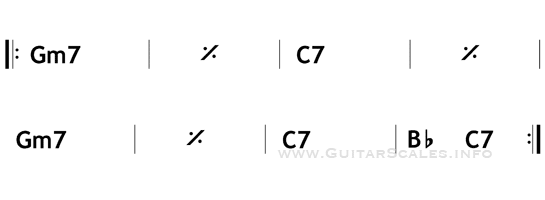This is a guitar lesson on how to use blues scales, with audio examples and a backing track so you can play your own blues solo.
After the pentatonic minor scale, the blues scale is probably the most commonly used guitar scales in improvisation. In fact, the blues scale is simply a pentatonic minor scale with an extra note added. This extra note, or blue note, is a the flattened fifth, and is what gives the scale its immediately recognisable 'bluesy' sound.
 The flat five (or flattened fifth, or blues note – there are several ways of referring to it) interval is easy to hear on the guitar. Play the root note on the sixth (lowest) string, then move to the fifth string and play the note that is a fret higher. Now play both notes at once. It is this slightly discordant interval that gives the blues scale its distinctive sound.
The flat five (or flattened fifth, or blues note – there are several ways of referring to it) interval is easy to hear on the guitar. Play the root note on the sixth (lowest) string, then move to the fifth string and play the note that is a fret higher. Now play both notes at once. It is this slightly discordant interval that gives the blues scale its distinctive sound.
In the key of A, the flat five would be an E flat. In the key of E, the flat five would be a B flat. In improvisation, musicians can either play the blues note quickly, as part of a phrase, before resolving the discordant note into the perfect fifth or fourth (the notes directly above and below the blues note) , or they can emphasise the blues note, by holding it for several beats or by playing it heavily. Learn the blues scales here: Blues Scales Guitar, and identify the blues notes in each scale shape. Experiment with playing them as part of some improvised phrases, and find out how you like to play them.

Blues Scale Example Solo
Listen to this example of how to use blues scales. The solo uses G blues scales. (See this page: Blues Scales Guitar, for a number of guitar scale shapes that can be used to play blues scales all over the guitar neck.)
Example Of Improvisation With Blues Scale
The example guitar solo is performed over this progression:

Blues Scale Play Along Backing Track
Blues Scale Backing Track
Now play along to this backing track, and improvise your own solo using the blues scale. Once you have learned the basic notes, and worked out the blues notes, you could start to incorporate some other blues guitar techniques, such as string bends, slides, and heavy vibrato.
Guitar Scales Backing Tracks.
Our Blues Guitar Backing Tracks provide excellent practice for soloing with blues scales, and have been produced so you can use them in performance, too. Featuring several popular blues styles and keys, they will provide inspiration whenever you need it! For more details and to play along with samples tracks see: Blues Backing Tracks.

Blues Funk Video Backing Track
Play along to this blues guitar backing track using C blues scales:
![]()



Love the track – playing some nice funky blues over here in Vancouver! x
Nice track! More funk than blues but still good for playing blues scales over. How about a real blues backing track too?